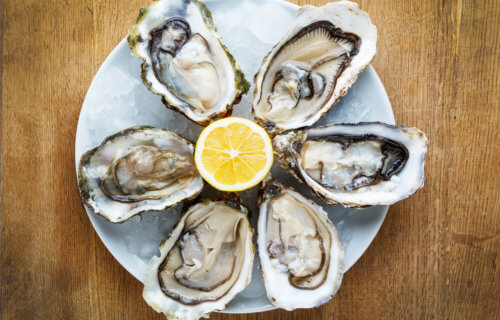Multivitamins of the future could come in the form of fresh oysters thanks to creation of ‘vitamin bullets.’
CAMBRIDGE, England — How about switching out your daily multivitamin pill or gummy for a daily multivitamin clam or oyster? A team of scientists at Cambridge University just developed a way to “supercharge” shellfish with all of the nutrients and vitamins a person needs on a daily basis.
Nicknamed “vitamin bullets,” these tiny nutrient-packed microcapsules fed to shellfish represent a new possible solution to a major global problem: worldwide nutrient deficiencies. It isn’t as severe a problem in the United States, but a staggering portion of the world’s population (over two billion people) are nutrient deficient.
Bivalve shellfish (oysters, mussels, clams) are already some of this planet’s healthiest and most sustainable sources of animal protein. So, the team at Cambridge decided it would be a good idea to try fortifying such foods with additional nutrients and vitamins. Furthermore, when a clam or oyster is eaten, the entire organism is consumed. This is another reason why bivalves are perfect for this endeavor. When we eat a bivalve, we’re also eating everything that animal consumed near the end of its life.
How vitamin bullets work
The process for vitamin bullets is quite simple. A microcapsule is fed to the shellfish, then the shellfish is eaten by a human. That way, the eater enjoys not only the bivalve’s protein, but also the nutrient-packed capsule within.
For the study, the research team tried out capsules fortified with vitamins A and D on 100+ oysters to find the ideal dosage. It was also during this period that researchers discovered the best time to feed the capsule to a shellfish is roughly eight hours until the end of “depuration.” This is when bivalves are kept in cleansing tanks after harvest.
Researchers say that oysters on the vitamin bullet diet have roughly 100 times more vitamin A and 150 times more vitamin D than normal oysters. Moreover, these oysters even pack a bigger nutritional punch than heart-healthy salmon. It’s no secret that the popular fish is one of the top natural sources of vitamins. Yet in comparison to salmon, the shellfish on the vitamin bullet diet deliver 26 times more vitamin A and up to four times more vitamin D.
Eating just two fortified oysters would be enough for someone to meet the Recommended Dietary Allowance (RDAs).
Shellfish could solve a global health issue?
Just how prevalent are vitamin A and D deficiencies around the world? Data shows that 76% of children in Ghana are vitamin A deficient. A whopping 85% of the entire Indian population is vitamin D deficient. Even in the United States, over 40% of citizens frequently experience a vitamin D deficiency.
“We have demonstrated a cheap and effective way to get micronutrients into a sustainable and delicious source of protein. Targeted use of this technology in regions worst affected by nutrient deficiencies, using carefully selected bivalve species and micronutrients, could help improve the health of millions, while also reducing the harm that meat production is doing to the environment,” says PhD student David Willer in a release.
The scientists are already in discussions with various seafood manufacturers about testing out their capsules on more bivalves.
“We are very excited about BioBullets’ potential. We are now establishing links with some of the world’s biggest seafood manufacturers to drive a step change in the sustainability and nutritional value of the seafood that we consume,” comments Dr. David Aldridge, a professor in Cambridge’s Department of Zoology. Aldridge also owns BioBullets, the company manufacturing the microcapsules.
Importantly, this entire process doesn’t end up significantly raising the price of bivalves either. The research team estimates that each fortification will add a mere $0.0056 to the cost of producing each oyster.
The study is published in Frontiers in Nutrition.
